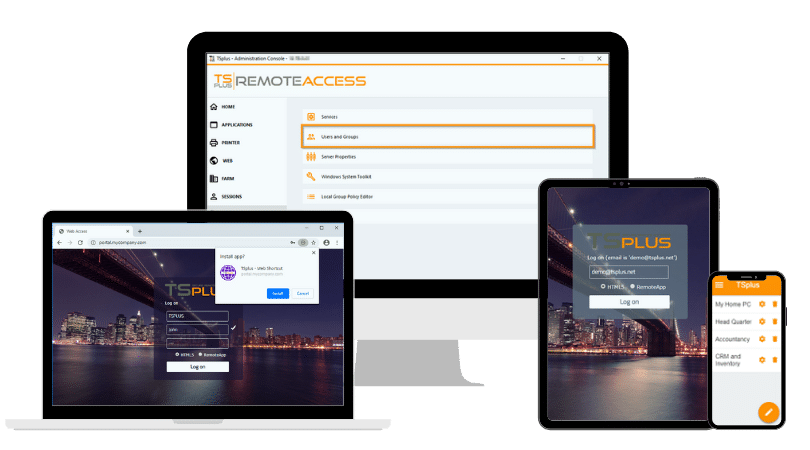¿Qué son los números de puerto RDP y para qué sirven?
In diesem Artikel werden wir uns mit den RDP-Portnummern, ihrer Funktionsweise, gängigen Konfigurationen und bewährten Praktiken für die Verwaltung und Sicherung dieser Ports befassen.
Vuoi vedere il sito in un'altra lingua?
TSPLUS BLOG
The need for seamless access to distant computers has never been greater. This is where RDP Remote Desktop Software kommt ins Spiel. Egal, ob Sie ein IT-Experte sind, der Server verwaltet, oder ein Geschäftsinhaber, der Remote-Teams unterstützt, das Verständnis, wie RDP funktioniert und welche praktischen Anwendungen es hat, kann die Produktivität und Sicherheit erheblich steigern. Entdecken Sie in diesem Artikel, was RDP Remote Desktop Software ist, wie sie funktioniert, ihre Hauptmerkmale, Vorteile, Anwendungsfälle und bewährte Sicherheitspraktiken.
)
Remote Desktop Protocol (RDP) es un protocolo propietario desarrollado por Microsoft, diseñado para permitir a los usuarios conectarse y controlar computadoras remotas a través de una conexión de red. Introducido inicialmente como parte de Windows NT 4.0 Terminal Server Edition en 1998, RDP se ha convertido desde entonces en una piedra angular de las soluciones de acceso remoto en todo el mundo. Es una tecnología esencial para los administradores de TI y las empresas que necesitan acceso remoto seguro a servidores, estaciones de trabajo e incluso escritorios virtuales basados en la nube.
RDP opera su porta 3389 by default and uses a secure, encrypted connection to facilitate communication between a client device and a host machine. The protocol efficiently transmits graphical interface data between the two devices, allowing the remote user to view and interact with the host’s desktop environment as if they were physically present.
RDP es una herramienta versátil con soporte para varias funciones, incluyendo:
Su integración con Windows hace que RDP sea una opción popular para empresas de todos los tamaños, permitiendo un acceso remoto seguro y escalable para soporte de TI, trabajo remoto y gestión de servidores.
RDP software works by establishing a secure, encrypted connection between a client device and a host machine, allowing users to remotely access and control the host computer. This process relies on a series of critical steps that ensure both functionality and security:
During this process, RDP utilizes strong encryption protocols (such as TLS or SSL) to ensure that all data transmitted between the client and host remains confidential and secure.
RDP remote desktop software is favored for its robust feature set, making it suitable for a wide range of IT environments, from small businesses to large enterprises. Its versatility and powerful capabilities allow IT administrators to maintain secure, efficient, and scalable remote access. Here are some of the most important features that make RDP an essential tool for remote connectivity:
These features make RDP remote desktop software an indispensable tool for businesses seeking secure, scalable, and efficient remote access solutions.
Implementar software de escritorio remoto RDP ofrece numerosas ventajas para las empresas y los equipos de TI, convirtiéndolo en una herramienta versátil para la gestión remota, el soporte y la productividad. Aquí están los beneficios clave en mayor detalle:
RDP permite a los administradores de TI mantener, monitorear y solucionar problemas en múltiples sistemas desde una única ubicación centralizada. Ya sea gestionando servidores locales, máquinas virtuales basadas en la nube o estaciones de trabajo remotas, los equipos de TI pueden resolver rápidamente problemas técnicos sin estar físicamente presentes. Este enfoque centralizado mejora significativamente la eficiencia en entornos de múltiples sitios, como cadenas minoristas, instituciones educativas y oficinas distribuidas.
As remote work becomes the norm, RDP provides a secure, seamless way for employees to access their office desktops from home or any location. Employees can use business-critical applications, access internal resources, and work on projects just as they would in the office. This not only ensures business continuity but also enhances employee flexibility and satisfaction.
En réduisant le besoin de visites de support sur site, RDP réduit les dépenses opérationnelles. Les équipes de support informatique peuvent résoudre les problèmes des utilisateurs à distance, éliminant ainsi les coûts de déplacement et réduisant les temps d'arrêt. Les entreprises peuvent également économiser sur les dépenses matérielles en centralisant les ressources informatiques sur des serveurs puissants, auxquels les utilisateurs peuvent accéder à distance.
RDP est équipé de mesures de sécurité robustes, y compris l'authentification au niveau du réseau (NLA), qui exige que les utilisateurs s'authentifient avant d'établir une connexion. De plus, la transmission de données chiffrées utilisant TLS or SSL garantiza que la información sensible permanezca segura, protegiendo contra el acceso no autorizado.
Modern RDP clients are compatible with various operating systems, including Windows, macOS, Linux, Android, and iOS. This cross-platform support ensures that users can connect to remote desktops from virtually any device, enhancing accessibility for both IT administrators and end-users.
RDP remote desktop software es una herramienta versátil utilizada en diversas industrias, que proporciona soluciones de acceso remoto seguras y eficientes. Aquí están los casos de uso más comunes donde RDP resulta invaluable:
IT teams use RDP to provide remote support, diagnosing and resolving technical issues on user devices without needing to be physically present. Whether fixing software glitches, installing updates, or troubleshooting system errors, RDP allows IT professionals to take full control of user devices, significantly reducing response times and enhancing support efficiency. This capability is especially critical for organizations with distributed teams or clients in different locations.
System administrators leverage RDP to manage and maintain servers hosted in remote data centers. This includes monitoring server health, performing system updates, configuring server settings, and handling security management. By using RDP, administrators can efficiently maintain multiple servers from a centralized location, ensuring optimal performance and security.
As hybrid and remote work become standard, RDP provides employees with secure access to their work computers from home or any location. This enables them to work on critical files, use specialized software, and maintain a consistent work environment, enhancing productivity without sacrificing security.
Teams can leverage RDP for collaborative tasks, such as sharing screens for presentations, conducting live training sessions, or guiding team members through complex tasks. Instructors can take control of participants' screens to demonstrate workflows, troubleshoot problems, or teach new skills. This makes RDP an excellent tool for onboarding new employees or providing ongoing training.
These use cases demonstrate the flexibility of RDP, making it a critical tool for businesses seeking to enhance IT support, streamline server management, support remote employees, and foster team collaboration.
While Remote Desktop Protocol (RDP) is a powerful tool for remote access, it is also a common target for cyberattacks if not properly secured. Unauthorized access, brute force attacks, and ransomware are just a few of the threats that can exploit unsecured RDP connections. To ensure your RDP implementation is secure, follow these best practices:
By implementing these best practices, you can significantly enhance the security of your RDP deployment, protecting your systems, data, and users from potential threats.
Pour les entreprises à la recherche d'une solution RDP sécurisée, évolutive et conviviale, TSplus Remote Access offers a comprehensive platform designed to enhance remote connectivity. With robust security features, multi-user support, and cross-platform compatibility, TSplus empowers organizations to maintain secure remote access while maximizing productivity. Whether you are looking to support remote workers, manage distributed servers, or provide efficient remote IT support, TSplus has you covered.
Remote Desktop Protocol (RDP) est devenu un outil indispensable pour les entreprises de toutes tailles, offrant un accès sécurisé et flexible aux ordinateurs et serveurs distants. Que vous soyez un administrateur informatique gérant des serveurs distants, un technicien de support aidant les utilisateurs, ou un employé accédant à votre ordinateur de travail depuis chez vous, RDP propose une solution fiable pour une connectivité sans faille. Cependant, il est crucial de s'assurer que votre déploiement RDP est sécurisé et optimisé pour maintenir les performances et protéger les données sensibles.

TSplus Accesso Remoto Prova Gratuita
Alternativa definitiva a Citrix/RDS per l'accesso desktop/app. Sicuro, conveniente, in locale/cloud.
Soluzioni di accesso remoto semplici, robuste e convenienti per professionisti IT.
La cassetta degli attrezzi definitiva per servire meglio i tuoi clienti Microsoft RDS.
 Contattaci
Contattaci